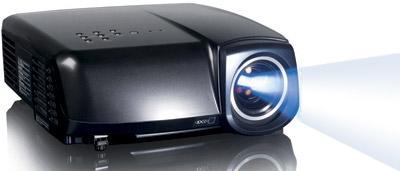Test Report: Mitsubishi

| The Short Form |
| $3,995 / MITSUBISHI-PRESENTATIONS.COM / 888-307-0349 |
| Snapshot |
| A reasonably priced 1080p front projector that doesn't skimp on picture quality or installation features. |
| Plus |
| • Crisp 1080p picture with natural color • Strong blacks and shadow detail • Excellent standard-def picture upconversion • Flexible setup and adjustment options |
| Minus |
| • Reds sometimes look overly vivid • Price $3,995 |
| Key Features |
| • 1080p resolution • 1.6x zoom lens • Motorized zoom, focus, and horizontal/vertical lens shift • Accepts 24p input and frame-doubles to 48p • 160-watt UHP lamp with 5,000-hour life (in Low mode) • Inputs: 2 HDMI 1.3; component-, composite-, and S-video; VGA; RS-232C • 131/4 x 5 x 14 in; 121/2 lb MITSUBISHI-PRESENTATIONS.COM :: 888-307-0349 |
Mitsubishi has long been known as the Big-Screen Company, mostly due to the strength of its extensive lineup of rear-projection TVs. But with Mitsubishi (like every other TV manufacturer) now shifting its focus to flat-panel TVs, the Big-Screen torch appears to have been passed to its front-projector division. The Name_here (last Mitsubishi front projector I tested, the HC4900), offered strong 1080p-rez performance at an affordable three-grand price tag. And since then, there has also been a steady buzz surrounding a step-up model, the HC6000. But just how big a step up is it?
A key attraction of the HC6000 is its well-regarded Silicon Optix Reon video processor. Beyond that, the projector's Automatic Iris function benefits from a new algorithm that optimizes picture contrast on a scene-by-scene basis. Most other LCD and LCoS front projectors offer this feature, but the adjustments happen so rapidly on the HC6000 that they're virtually transparent. Also, it's one of the quietest projectors I've ever tested. With the Low lamp mode selected, you'll barely know this thing is turned on.
Adding to the HC6000's stealthy appeal is its compact black case. The control buttons are on the top surface, and the back-panel connections include two HDMI 1.3 jacks, a component-video input, and a VGA port for plugging in a computer. Custom-install-friendly features include an RS-232 input and a 12-volt output.
The projector's remote control has been designed for maximum utility in dark rooms. It has a fully backlit keypad, and the control buttons covering its surface let you quickly switch sources and make picture adjustments without having to root through onscreen menus.
To switch aspect ratios, you repeatedly press the remote's Aspect button to toggle through the display modes. For standard-def programs, you can select 4:3, 16:9, Zoom 1 or 2, or Stretch. For high-def 720p and 1080i/p signals, choices are limited to 16:9 and a 2.35:1 mode that's meant for use with same-aspect-ratio projection screens.
SETUP
To test the HC6000, I positioned it about 13 feet from an 80-inch-wide (92-inch-diagonal) Stewart Filmscreen GrayHawk RS screen in my medium-gray home theater. Setup is simplified by the motorized zoom, focus, and horizontal/vertical lens-shift features, which let you fully tweak image alignment using just the remote.
After plugging my system into the HC6000 via HDMI, I called up the Image setup menu and selected the Enhanced Input Level option. This setting lets the projector display below-black (0 IRE) and above-white signals. In the projector's Signal menu, I configured both HDMI inputs for 0% picture overscan. The HC6000 will also accept a 24p input from a Blu-ray Disc player, automatically frame-doubling the signal to a 48p display.
The HC6000 doesn't offer any general picture presets, but it does provide Cinema, Sports, Video, and Auto gamma presets. After you've optimized the picture settings, you can store your adjustments in the AV Memory Save submenu. Three separate memories are available for each of the projector's inputs, and you can call them up easily by pressing the associated AV Memory button on the remote.
Like any sophisticated front projector, the HC6000 is stocked with plentiful settings to tweak its picture. Of its three color-temperature presets, the Mid (medium) mode delivered the most accurate color. Auto Iris functions typically create deeper-looking blacks on front projectors, but they can also rob the picture of punch by reducing the brightness of white highlights. With the HC6000, however, images looked more satisfying and punchy with Auto Iris on. And true to Mitsubishi's claims, its action was transparent and completely silent at all settings.













































